Does anyone remember an Irish bastible? My granny could cook the most amazing meals using a cast iron bastible suspended over an open fire.
She even cooked bread in a bastible, without the aid of a fancy thermometer or convection fan oven. Yes! My granny baked the most delicious loaves of Irish soda bread, in the simplest oven of all, a bastible pot.
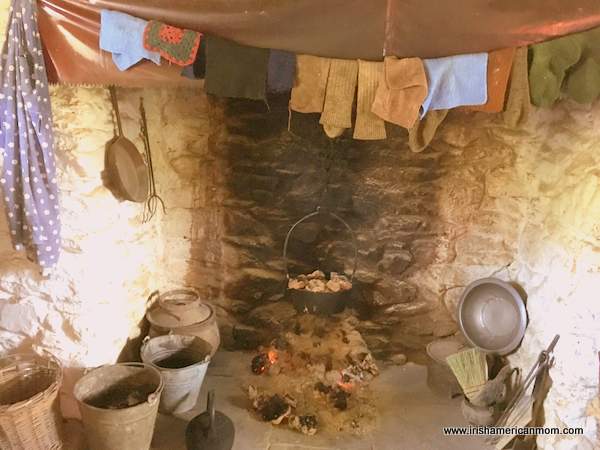
And so today I thought I might share some photos of bastibles with you, so that when I reminisce about olden times in Ireland, you'll know exactly what I'm talking about.
Table of Contents
Cooking Over an Open Fire
In years gone by an open turf fire was the center of every Irish home. The hearth was the heart of the home, where everyone gathered to share the warmth and light of the lapping flames. But fires did not just burn at night. The fire was watched and kindled all day long since few Irish rural cottages could boast a fancy oven for cooking.
No! All the cooking was done over an open fire and the necessary tool to accomplish this task was of course, the bastible.
Bastibles were flat-bottomed pots and Irish women in days gone by were master bastible chefs.
This cast iron pot was the primary cooking tool in many an Irish kitchen in the nineteenth and early twentieth. My granny used one right up until the 1960's.
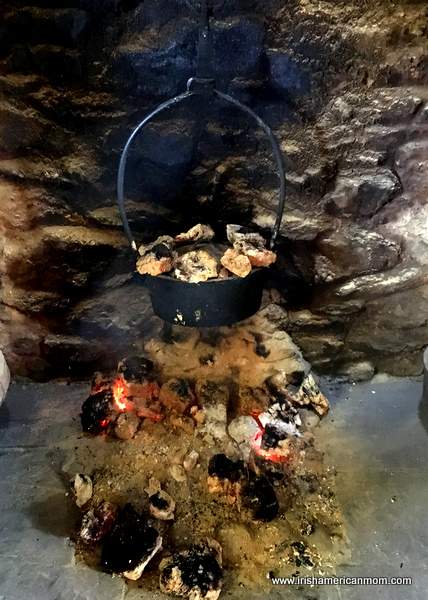
This simple pot could be used to roast a duck, a chicken or a goose, and of course, Irish soda bread was artfully baked in bastibles by our grannies and great grannies.
Skill of Cooking Over an Open Fire
However baking and cooking over an open fire was no easy task and required skills passed down from generation to generation. If the fire was too hot, burnt food was guaranteed. An insipid fire could leave food undercooked.
Temperature was controlled by placing hot sods of turf on top of the lid. My granny knew exactly how many sods were needed for high or medium heat. Many years of practice ensured the perfect results every time.
The bastible was my granny's oven. She also had a three legged, pot-bellied, cast iron pot that was used for boiling potatoes. The big difference between these pots was their shapes. A pot-bellied bottom was for boiling, while a flat bottom was for baking and roasting.
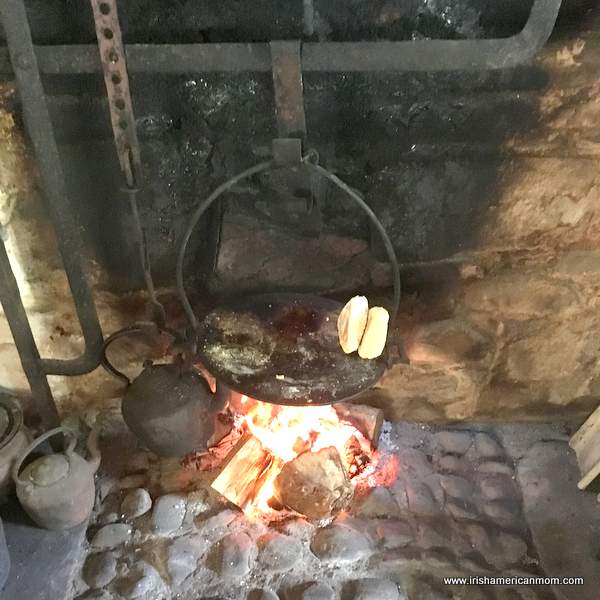
And then there was the griddle pan. This was thinner than a bastible, but also flat. It was used for making griddle cakes, potato cakes, and boxty.
I remember the day my uncle bought a range to replace the open fire in my granny's old farmhouse kitchen. It was a happy day as a little bit of modern convenience finally arrived in the old cottage. But even though I was only 5 or 6 years old, a pang of sorrow and nostalgia quivered through my soul, as the range was fitted in place, covering forever the spot where the turf fire had once brightened the hearth.
Modern times had come to my granny's kitchen, but I missed the iron crane with the kettle hanging above the flames. Despite my young years, I knew that life as we knew it was changing, never to return to how it once was.
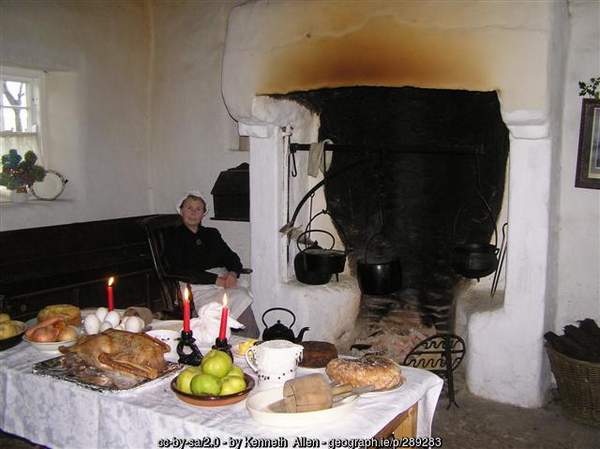
How This Pot Was Named
And so, you may wonder how this simple pot got its name. 'Bastible' sounds like a derivative of an old Irish or Gaelic word. However, the name is believed to have come from the town of Barnstable in England. This type of cooking vessel is said to have been first made there.
I'm not sure if these pots had a different name in other regions of Ireland. Bastible was the term we used in County Cork. Let me know in the comments section if you called these pots by a different name.
And there you have it! A little trip down memory lane, with a quick look at the old Irish bastible.
Do you also feel a twinge of nostalgia when you see these old pots? Oh, such fond memories of the good old days.

Slán agus beannacht,
(Goodbye and blessings)
Mairéad -Irish American Mom
Pronunciation - slawn ah-gus ban-ock-th
Mairéad - rhymes with parade
You might enjoy some Irish recipes. Check out my complete Irish recipe index here....




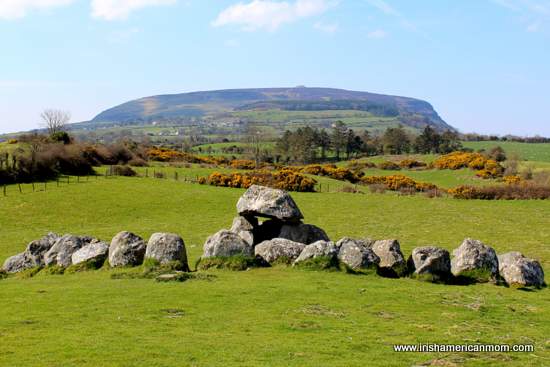




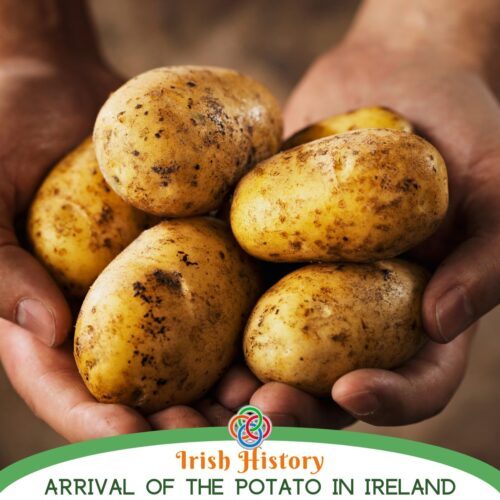
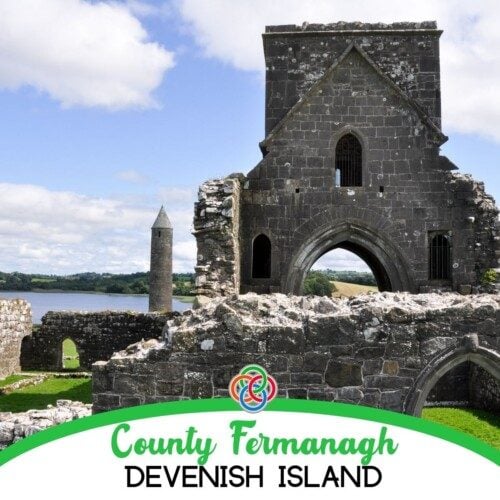






Kathleen Dempsey
My Aunt made the best bread in a bastible over an open fire. I was so sad to see it go and the large cooker in it's place
Irish American Mom
Hi Kathleen - I too remember the sadness of seeing the old open fire being replaced with a range. I know it made life much easier for my granny to have a stove to cook, but there was something so welcoming about the black kettle hanging over the fire, always ready and waiting to make a pot of tea.
Thanks so much for stopping by
All the best,
Mairéad
Noel
There was a story on irish radio yesterday (pictures posted on Twitter) of an apple pie being baked in a bastible.
Irish American Mom
Thanks Noel for that update. I found the link if anyone would like to check out the video.
https://twitter.com/hqmulligan/status/1307218421432684548
Thady
Inspired by the older generation and trying to preserve the beauty of turf fire cooking for another generation or two I still do cook on the open fire. Plus griddle bread is delicious!
Irish American Mom
Hi Thady - That's wonderful to hear. Griddle bread is a wonderful taste of Ireland and every so tasty for sure. Thanks for stopping by.
All the best,
Mairéad
Penny Wolf
Nostalgia aside, as well as flavor of food and drink cooked over a fire, it's the skills that are of value.
I have done period camping, 1700's America, and cooking and baking over a fire is a talent and skill that isn't born overnight. Some have a natural knack for it but for most of us practice makes almost perfect.
You are lucky to have lived it with your Granny even if it was brief. You know about it.
Irish American Mom
Hi Penny - Period camping sounds like a wonderful experience. What a great way to learn how our forefathers lived and survived. Cooking is a skill and an art when using a modern day oven, not to mind when using an open fire. My generation has lost so many skills handed down for generations, but I do feel blessed to have seen and experienced the old ways, even if I was too young to master the skills.
Best wishes,
Mairéad
A Connell
On the pots, the name was cast in, like le creuset, and that's what they were called!
Now they can be called anything (my mother's were French, and I'd be asked to take down the cruset), though now ' Dutch Oven ' is seen more often, probably because of US cooking programmes!
Slán 7 sláinte
Irish American Mom
Le Creuset pots are wonderful for cooking. Cast iron cooking was a staple in many different countries. Thanks for sharing your memories of your mother's French cookware.
All the best,
Mairéad
Diana Lopes
Oh, I definitely feel the nostalgia when I see these pots, and that's why I love reading posts like this. Please keep up! =)
Irish American Mom
Hi Diana - I'm so glad you enjoyed this little ramble about old Irish pots. Thanks so much for stopping by to check it out.
Best wishes,
Mairéad
Traci
This looks very similar to the dutch ovens we use. I use my cast iron dutch oven when we go camping and regulate the temperature by adding hot coals to the top. I only use mine a few times a year, but there is something about food cooked in it that makes it taste so much better. What wonderful memories of your Granny and her cooking. 🙂
Irish American Mom
Hi Traci - Cast iron cooking definitely adds a depth to flavors that cannot be replicated any other way. Lovely to hear you use your cast iron pot for camping trips.
Take care,
Mairéad
Lola Smith
My husband and I had the honor to visit Ireland this past March. It was truly a wonderful adventure. We would love to hear more of these stories you have and have enjoyed what you have provided for our imaginations. Thank you for your colorful and inspiring reads.
Irish American Mom
Hi Lola - I'm so happy to hear you had a wonderful time in Ireland. Many thanks for your kind words about my ramblings. It's always lovely to hear from readers who have been to Ireland and enjoy all things Irish.
Best wishes,
Mairéad
irishnannie
What fun, Mairead*, for you to bring our minds to a different time in the place that lives in our hearts.
My Dad, from Cobh, was always about his cast iron pan, but until today I have never even heard the word bastible. Thank you so much, as always, for bringing so many of us more of the history and culture we yearn to be more familiar with! God bless you, Mairead*. Your Granny, I feel sure, is very proud of you!
God bless Granny, too!
Irish American Mom
Hi Irishnannie - I'm sure your father enjoyed home cooking from a bastible in the days he spent in Ireland. No wonder he loved his cast iron pan.
Thanks for checking out my ramblings about the olden days.
Best wishes,
Mairéad
Maury
We too did a lot of period camping, and buried the cast iron pot in the ground and covered it with hot stones and wood! No food ever tasted better! Thank you for recalling those happy experiences to mind Mairead!
Jim Gorman
Your Irish art leaves me with a haunting feeling of nostalgia. I can't explain why, you must feel it and I suspect, you know.
Dan
yes also called bastible in west Waterford . Used to use one to make bread but it is just the Irish version of the dutch oven
Irish American Mom
Hi Dan - I'm so glad you too have lovely memories of bread making in a bastible. I recently visited the National Trails Museum in Casper, Wyoming and learned how the Dutch oven was used for cooking over an open fire throughout America in the 19th century especially when the wagon trains moved west. Thanks for checking out my ramblings.
All the best,
Mairéad
M Kiely
Hi..watched a programme on telly last night about cooking in Albania...right now they are cooking with the bastibles as we in Ireland did long go..brought back happy memories..and let's not forget the old cast iron kettle hanging from the crane always on the boil...Mgt in Limerick
Irish American Mom
Thanks so much for checking out this blog post. I too have happy memories of the bastible or cast iron kettle on the crane over the open fire in my granny's house. Amazing that bastibles are still in use in Albania. Food tastes great from a griddle pan or cast iron bastible.
All the best,
Mairéad
Rhona
Hi Mairéad,
I'm coming really late to this post, but I wanted to add my word of thanks for this article. I remember my great aunt lamenting the loss of her open fire when she had "modernized" and got a Stanley range in the 70's. I have to say that the food she made was still the best I ever tasted, no weighing ingredients for baking and everything coming out perfectly. But as a child, I found watching another elderly relative cooking over her open fire absolutely fascinating. Fresh soda bread and homemade rhubarb jam on a summer afternoon. Best food ever! 😉
Where was the first picture of the open fire taken?
Will check out your blog from now on. 😉
Rhona
Irish American Mom
Hi Rhona - I too remember when my granny got her first Stanley range. Her kitchen was transformed when the open fire was replaced, but I still longed for the good old days, listening to the whistling kettle hanging on the crane over the fire. The first picture was taken at Muckross Traditional Farms in Killarney, County Kerry. They demonstrate cooking over the open fire, which was a real eye opener for my kids when I took them there. We also got to see a blacksmith at work, and his craftsmanship fascinated my troop.
Thanks so much for stopping by and it's lovely to hear you'll be back again for more Irish recipes and ramblings.
Best wishes,
Mairéad
Aidan Mac
Nice article.
I too remember my Nana Kate in County Mayo (County of the most Irish Emigrants) cooking the old way.
Baking bread in the flat Iron pot and turning it over in her open hands, feeling the weight and tapping the crust to check it was baked right.
The soda bread was heaven, thick cuts...still warm with some salty butter melting on top and maybe even fried in the pan in the fat from fried bacon.
The bread had to be eaten that day for the nice crust and soft centre as in a day or two it was like a rock.
That's how you know the real soda bread, its not like the ever-fresh pretend soda breads, it had to be eaten a day or two after baking or it would go stale. I miss those days and the smell of the turf.
I was a teenager when the fire was changed to a small standard open fire.... what a pity and it gave me a sadness in my heart to feel another little loss of our old ways.
I need to say that I admire and appreciate you Irish Americans because you hold precious the old days and traditions that many in Ireland take too much for granted and have even forgotten.
In fact many traditions nowadays have been corrupted by anglo norman heritage in strongholds of it such as Cork and Kerry.
But you Irish Americans are derived from an older, purer stock, from the uncorrupted traditions of the old Gaelic Irish in Connacht and Ulster as opposed to the southern Hiberno Anglo Normans of Munster and Leinster. This is why your remembrance of Irish tradition is so important as, though displaced, you tap into something older and purer and less corrupted....
Gach dea ghuí
Irish American Mom
Hi Aidan - Thanks so much for checking out my ramblings and memories of my granny from Cork cooking in a bastible. My family all hail from County Cork, so perhaps my Irish cultural view would be influenced by the Hiberno Anglo Normans. However, I think my Geary ancestors were very Gaelic in their ways. I grew up in Ireland, so I may not truly qualify as an Irish American, other than the fact that I became an American citizen many years ago. I do agree with you, that the Irish in American handed down a great love of Irish heritage and culture to their families. Younger generations of Irish people do not fully understand the connection Irish Americans feel for the land of their ancestors.
Thanks for adding to our discussion.
All the best,
Mairéad
Aidan Mac
Thank you Mairéad, lovely blog.
I must check if it was also called a bastible in the West of Ireland?
Happy New Year!
Irish American Mom
Happy New Year to you too, Aidan.
This name was definitely not used in Donegal, but I'm not sure about Galway and Mayo. It may be associated with Munster only.
All the best,
Mairéad
jeff
We were trying to figure out what the name of this restaurant meant ..
https://www.bastible.com/
now we know ! thanks !
Irish American Mom
Hi Jeff - I'm so glad my article helped. Their food looks lovely.
All the best,
Mairéad